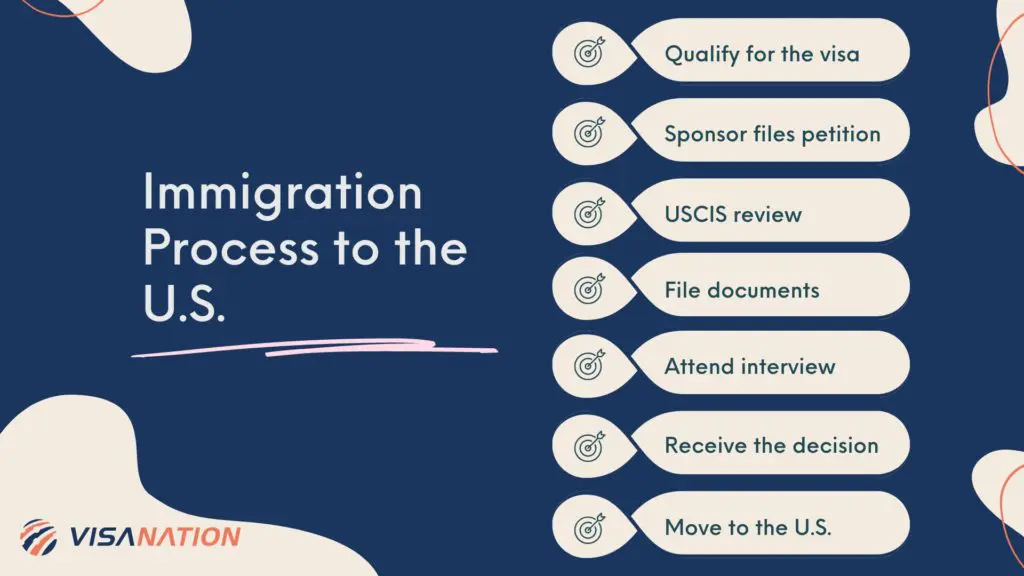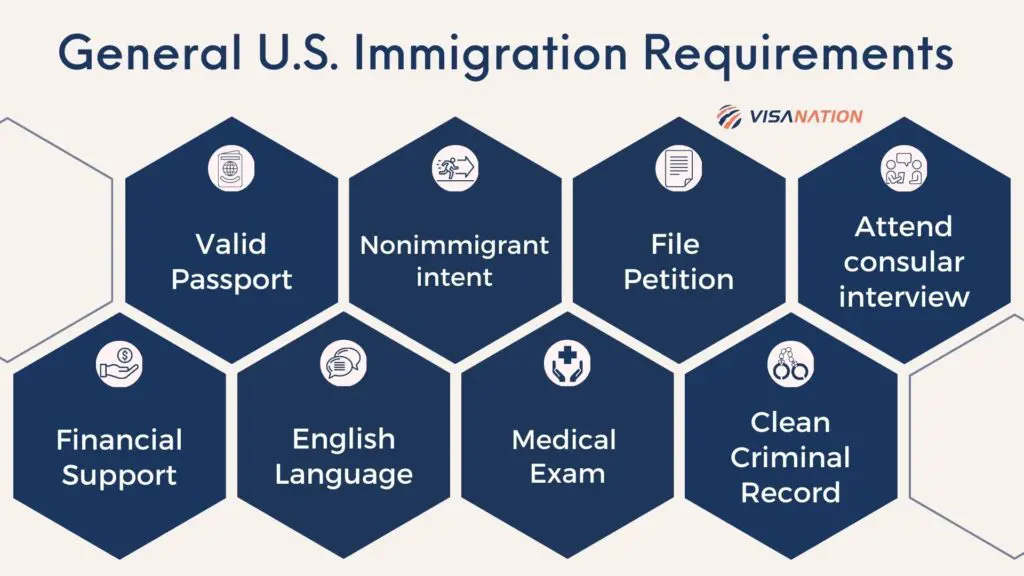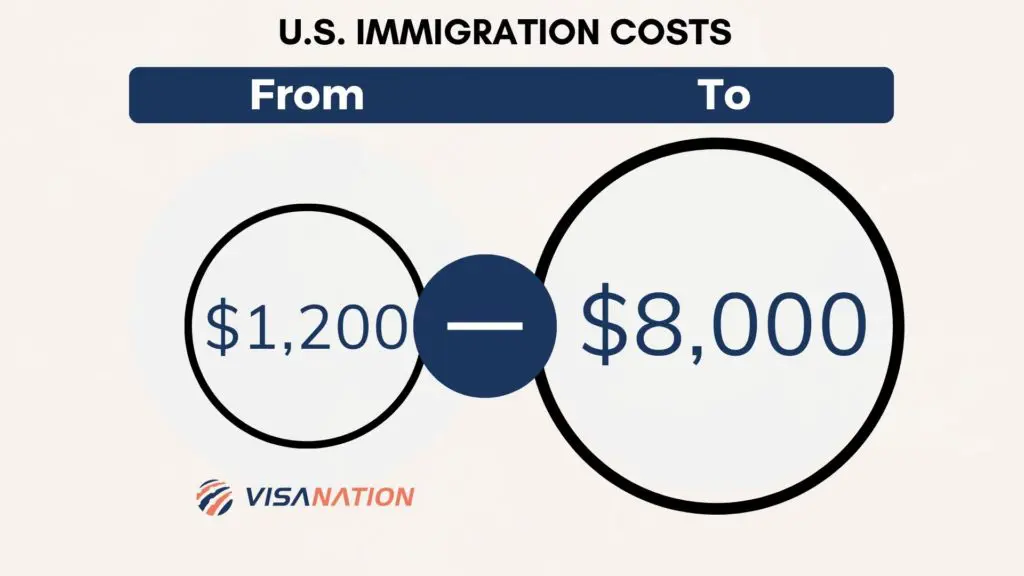The U.S. is the number one destination for many immigrants worldwide. In this guide, we will demonstrate how to immigrate to the U.S. We will go over different types of immigration programs and discuss which options might be the best for you. In addition, we will provide various alternatives for you to choose from.
How to Immigrate to the U.S.
You can either move to the U.S. on an immigrant visa, which provides you with permanent residency in the country, commonly known as a green card, or on a non-immigrant visa, which grants you a temporary stay in the country. Both options require applicants to fulfill the eligibility criteria of the particular visa that they are applying for.
Immigrant vs. Nonimmigrant Visas
There is a key difference between the two types of visas:
Immigrant Visa – Immigration to the U.S. can take different forms. The most common understanding of immigrating to the U.S. is gaining permanent residency, which essentially means gaining a green card. A green card will allow you freedom of employment with any employer and make you eligible for U.S. citizenship if you pass all other requirements.
Non-Immigrant Visa – The other option is to come to the U.S. on a temporary basis. This option is available for work reasons, tourism and business visits, studies, or to bring a fiancé for marriage. Most non-immigrant visas are renewable, so that you can stay in the country for longer. However, they do not provide you with permanent residency like immigrant visas do.
Immigration Process
The entire immigration process is highly tailored to the visa that you are applying for. However, the process below is a general overview of how to immigrate to the U.S.
- Choose the type of visa
- Fulfill the requirements for the visa
- Cover the costs of the application
- Apply for the visa
- Wait for the result of your application
- Move to the U.S.

Different Types of Immigration to the U.S.
If you are considering moving to the U.S., you are in luck because there are numerous options available to you. These options are tailored for various reasons such as family, work, humanitarian, and diversity. Below, we will explore each type in more detail.
Family-Based Green Cards
These green cards are a type of visa that allows you to become a lawful permanent resident in the U.S. based on your relationship with a U.S. citizen or a lawful permanent resident (LPR) family member. This means that your spouse, parent, child, or sibling is a U.S. citizen or LPR and acts as a petitioner to sponsor your immigration. There is a limit on how many family-based immigration applications are accepted from each country, so not every application is processed. However, your immediate relatives are not affected by such limits.
Here is a list of family-based visas that you can apply for and won’t be subject to the applicable limit:
- IR-1 and CR-1 – Spouse of a U.S. citizen
- IR-2 – A United States citizen’s unmarried child under the age of 21
- IR-3 – An orphan adopted abroad by a U.S. citizen
- IR-4 – An orphan to be adopted in the United States by a U.S. citizen
- IR-5 – A United States citizen’s parent who is at least 21 years of age
Employment-Based Green Cards
The employment-based green cards allow foreign nationals to live and work permanently in the U.S. Eligibility for these visas often favors individuals with sought-after skills, such as scientists, engineers, or healthcare professionals.
To apply, applicants must have a job offer from a U.S. employer who is willing to sponsor their application. Most of the time, the employer must prove that no qualified U.S. worker can fill the position; however, there are exceptions. There are different categories of employment-based green cards, each with unique eligibility requirements and application processes. These categories include priority workers, highly skilled professionals, and certain special immigrants.
While getting this type of green card can be complex, it presents an attractive option for permanent residency in the U.S. for eligible applicants.
The following work green cards have the option to obtain permanent residency:
- EB-1 Green Card for Priority Workers – This category includes individuals who possess the extraordinary ability, outstanding professors and researchers, and multinational executives and managers.
- EB-2 Green Card for Professionals with Advanced Degrees or Exceptional Ability – This category includes individuals with advanced degrees and those with exceptional ability in the sciences, arts, or business.
- EB-3 Green Card for Skilled Workers and Professionals – This category includes skilled workers, professionals, and other workers who are not seasonal or temporary.
- EB-4 Green Card for Special Immigrants – This category includes religious workers, broadcasters, and certain other special immigrants.
- EB-5 Green Card for Investors – This category includes foreign nationals who invest a minimum amount of capital in a U.S. commercial enterprise that creates jobs.
The following work visas allow workers to work in the U.S. on a temporary basis without obtaining permanent residency:
- H-1B Visa – This visa is for foreign workers in specialty occupations that require specialized knowledge and a minimum of a bachelor’s degree.
- L-1 Visa – This visa is for intracompany transferees who work for a company with offices in the United States and abroad.
- E-3 Visa – This visa is for Australian citizens who will work in specialty occupations in the United States.
- TN Visa – This visa is for Canadian and Mexican citizens who work in certain professional occupations under the North American Free Trade Agreement (NAFTA).
- O Visa – This visa is for individuals who possess extraordinary ability in sciences, arts, education, business, or athletics.
- P Visa – This visa is for athletes, entertainers, and artists who are coming to the United States to perform.
- R Visa – This visa is for religious workers coming to the United States to work for a nonprofit religious organization.

Humanitarian Green Cards
A humanitarian-based green card, or a “special immigrant” green card, is a permanent residency or temporary status offered to individuals fleeing persecution or who have faced significant hardship in their home country or in the U.S. This program is available to refugees, victims of human trafficking, asylees, and others who have been issued visas through special programs or humanitarian parole.
To be considered for a humanitarian-based green card, applicants must meet specific criteria established by U.S. immigration laws. This includes demonstrating a well-founded fear of persecution based on religion, nationality, race, political opinion, or membership in a particular social group. The application process for a humanitarian-based green card can be intricate and necessitates detailed documentation of the applicant’s circumstances.
The objective of the humanitarian-based green card program is to provide individuals who have experienced significant hardship or persecution in their home country with an opportunity to attain safety and stability by relocating to the U.S..
The following green cards based on humanitarian reasons are available:
- T visa – This visa is open to individuals who are victims of severe human trafficking and cooperate with law enforcement to investigate and prosecute the crime.
- U visa – This visa is for individuals who are living in the U.S. and have suffered substantial physical or mental abuse. The victim must cooperate with law enforcement agencies.
- VAWA Green Card – This visa is granted to individuals who are victims of domestic violence or abuse by a U.S. citizen or permanent resident spouse or parent.
Diversity Lottery Green Cards
Every year, the U.S. holds a lottery for the diversity visa program, randomly selecting up to 55,000 applicants. This program is designed to promote diversity in the immigrant population of the U.S. To be eligible for the diversity visa, you must come from a country with low rates of immigration to the U.S. In addition, applicants must meet the following requirements:
- Have a high school diploma; or
- Equivalent education to a high school diploma; or
- 2 years of work experience in a qualifying occupation; and
- Pass a background check.
Immigration Requirements
The general immigration requirements depend on the specific visa that you are applying for. Below are some general requirements that apply to most U.S. visas:
- Valid Passport – all visa applicants must have a valid passport for at least six months beyond the intended period of stay in the United States.
- Nonimmigrant Intent – if you are applying for a temporary visa, then you must show that you have no intention of staying in the U.S. on a permanent basis.
- Petition – for some visa types, you must have a sponsor or petitioner who files a petition on your behalf. The petitioner must be a U.S. citizen or permanent resident.
- Consular Interview – almost all visa types require applicants to attend a consular interview at a U.S. Embassy or consulate in their home country.
- Financial Support – some visa types require applicants to show that they have enough financial support to cover their expenses for their residency in the U.S.
- English Language Proficiency – depending on the visa type, you may be required to demonstrate your proficiency in English.
- Medical Exam – some visa categories require applicants to undergo a medical exam to ensure that they are not carrying any infectious diseases.
- Clean Criminal Record – all visa applicants must demonstrate that they have not committed any crimes and have not been involved in any terrorist activities abroad or in the U.S.
It is essential to consult with a qualified immigration attorney to ensure that all requirements are met before applying for a U.S. visa.

Costs of U.S. Immigration
The average cost of immigrating to the U.S. is between $1,200 to $8,000. The cost of immigrating to the U.S. varies dramatically depending on the type of green card you are applying for and the facts of your case. There are various fees associated with the immigration process, including application fees, processing fees, and legal fees. Moreover, the fees will vary depending on whether you are applying for family, employer, student, or other immigration programs.
For some applications, you may need to demonstrate that you have sufficient funds to support yourself and any dependents while living in the U.S. This may include providing evidence of financial resources such as bank statements, investments, or a job offer with a salary that meets certain requirements. When considering residency by investment in the U.S., your costs will also include the costs of starting and operating your business.
Below is a table that shows how much various services or forms may cost you.
|
Form or Service |
Fee |
|
I-129F: Petition for Alien Fiancé(e) |
$675 |
|
I-130: Petition for Alien Relative |
$625 |
|
I-485: Green Card Application |
$1,440 |
|
I-864: Affidavit of Support |
$120 |
|
State Department Consular Processing |
$325 |
|
USCIS Immigrant Fee |
$220 |
|
EAD (I-765): Work Authorization Document |
$260 when filed with I-485, $470 standalone |

Applying for a Visa
Depending on your current location, the process for applying for a green card in the USA will differ. If you are already in the United States, you can file your application and remain in the country while it’s being processed, which is referred to as an Adjustment of Status (AOS).
However, if you are outside the United States, you’ll usually file your green card application from your home country and remain there while it’s processed by your local U.S. embassy or consulate, which is called consular processing.
It’s important to note that both pathways and it’s crucial to understand the difference between them. Nevertheless, the green card application process typically involves five basic steps regardless of whether it is for family immigration or employment immigration:
Step 1 – your sponsor will file a petition with the U.S. authorities;
Step 2 – USCIS will review and approve the petition;
Step 3 – you will file your green card application;
Step 4 – you will need to attend an in-person interview; and
Step 5 – you’ll receive a decision regarding your application.
If you’re applying from inside the United States, USCIS will process your application, and you’ll receive an appointment for your biometrics. If you’re applying from outside the United States, your application will be processed by your local consulate, and you’ll get your biometrics taken as part of your consular interview.
Ultimately, your green card will either be mailed to you or returned with a visa allowing you to travel to the United States, and once you arrive, your green card will be mailed to your U.S. address.
Immigration Processing Times
The processing time for U.S. immigration is anywhere between 3 months to 4.5 years and varies greatly depending on the type of immigration option you are applying for.
- Family-based application processing times can take anywhere from 8 months to 30 months. This depends on factors such as the applicant’s country of origin and the backlog of applications at the time of submission.
- Employment-based visa processing times, such as the H-1B, can take between 4 months to 9 months.
- Diversity lottery processing time is usually around 8 months; that is, the successful applicants will be notified in that time period.
- Asylum seekers’ application processing times vary dramatically between 4 months to over 4 years. Because your case must be heard and decided in court, this may significantly affect the processing time.
The above is just the general processing times for immigration to the U.S. Your personal wait time will depend on the type of immigration process, the type of visa, the country of origin, and the workload of the USCIS at the time.
It’s important for those seeking to immigrate to the United States to be aware of the potential processing times for their specific immigration option and to plan accordingly.
Living in the U.S. as an Immigrant
Living in the United States as an immigrant can be a rich and rewarding experience. There are many benefits why you may choose to immigrate to the U.S.
Benefits of Moving to the U.S.
Below are some of the benefits that you might consider before making your big move!
Diversity
The population of the U.S. is incredibly diverse. There are people from all over the world calling the country home. This diversity can make for a vibrant and multicultural society, with different customs, foods, and languages all coexisting in one place. It is very likely that you, as an immigrant, will find a community of people from the same country as yourself, making your move to the U.S. much easier.
Education
One of the many benefits of living in the U.S. as an immigrant is the opportunity to access a world-class education. The U.S. has some of the best universities in the world. A quality education can lead to better job prospects, higher salaries, and an overall improved quality of life for your entire family. There are many scholarships and financial aid for qualified students, which makes higher education studies more affordable.
U.S. Citizenship
U.S. citizens and green card holders can live and work in the U.S. without the need for a visa or work permit. They also can travel freely in and out of the country, and can even vote in elections! Additionally, becoming a citizen or obtaining a green card can offer a sense of security and stability, providing a pathway to permanent residency in the country for you and your family.
Working in the U.S.
Having a job in the U.S. can significantly benefit many immigrants. The U.S. job market is diverse and dynamic, with various industry opportunities. Many jobs offer high salaries and unique benefits. Depending on the company you work for, there could be some excellent career advancement opportunities.
Frequently Asked Questions About Immigrating to the U.S.
Below you will find answers to the most commonly asked questions:
How can I live in the USA legally?
There are various immigration options that allow you to live legally in the U.S. as a foreigner. One of the most common ones is to obtain a green card through family sponsorship, employer sponsorship, or throughout the diversity lottery. There are also many options that allow you to live temporarily in the U.S. These include temporary work, studies, or even investor options.
Is the USA a good country for a living?
The U.S. is arguably one of the best countries in the world to live in. It has one of the highest standards of living in the world, an excellent education system, and top-of-the-line healthcare. It is a country of diversity that is extremely multicultural and has a lot to offer to newcomers.

What is the easiest way to immigrate to the USA?
The U.S. is one of the easiest countries to immigrate to if you qualify for its immigration programs. For example, family-based immigration is a great option for people who have family members in the U.S. already. The entire process is relatively fast, depending on the circumstances, and is not very costly. If you don’t have family members in the U.S., your second-best option is employment-based immigration. A U.S. company would have to sponsor you to come to live and work in the U.S. as a foreign worker. Many foreign workers end up staying in the U.S. permanently.
How much money do I need to immigrate to the USA?
You will need between $1,200 and $8,000 to immigrate to the U.S. There is great variability in the costs because there are various immigration options available for foreign residents to come to the U.S. Each immigration program has different financial requirements. Additionally, the cost of your immigration will depend on whether you are hiring an immigration attorney or not.
Can I move to the USA without a job?
One of the best alternatives to moving to the U.S. without a job is either through a family green card or on a student visa. If you have a family member who is a U.S. citizen or a lawful permanent resident, then they can sponsor your immigration to the U.S. The process can be intricate depending on how you are related, and it is advisable to seek help from a qualified immigration attorney. Another option is to move to the U.S. for your studies. Many international students choose to study in the U.S. because of how prestigious the educational institutions are in this country.
How to choose an immigration lawyer
Finding an immigration lawyer involves research like any other high-value service or product, including ensuring they are registered with the bar association, seeing their reviews online, and reviewing their membership with professional bodies. After, schedule consultations for a good fit to see if they have experience with your case, and ask specific questions.
 Shilpa Malik
Shilpa Malik  Sabrina Saada
Sabrina Saada 

